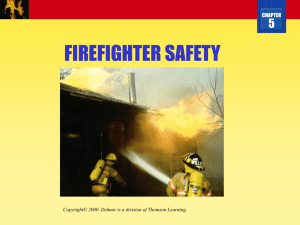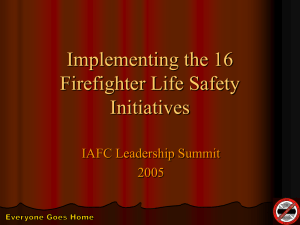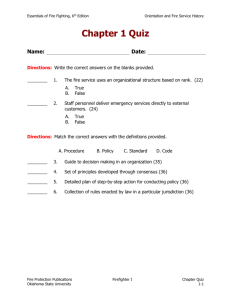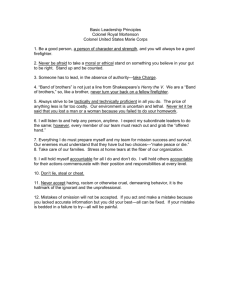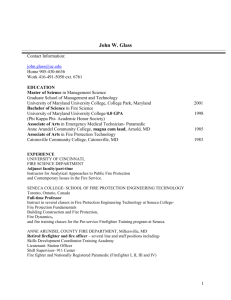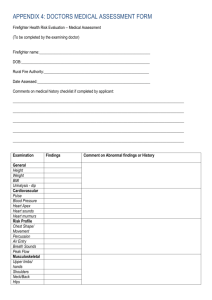Firefighter Safety
advertisement
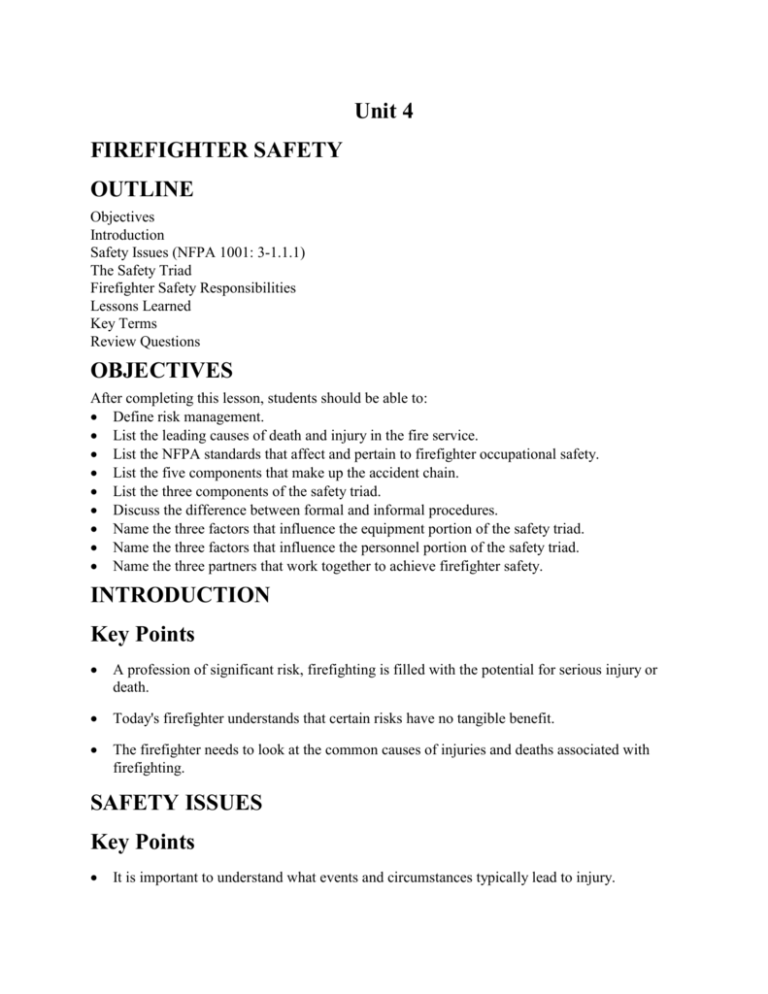
Unit 4 FIREFIGHTER SAFETY OUTLINE Objectives Introduction Safety Issues (NFPA 1001: 3-1.1.1) The Safety Triad Firefighter Safety Responsibilities Lessons Learned Key Terms Review Questions OBJECTIVES After completing this lesson, students should be able to: Define risk management. List the leading causes of death and injury in the fire service. List the NFPA standards that affect and pertain to firefighter occupational safety. List the five components that make up the accident chain. List the three components of the safety triad. Discuss the difference between formal and informal procedures. Name the three factors that influence the equipment portion of the safety triad. Name the three factors that influence the personnel portion of the safety triad. Name the three partners that work together to achieve firefighter safety. INTRODUCTION Key Points A profession of significant risk, firefighting is filled with the potential for serious injury or death. Today's firefighter understands that certain risks have no tangible benefit. The firefighter needs to look at the common causes of injuries and deaths associated with firefighting. SAFETY ISSUES Key Points It is important to understand what events and circumstances typically lead to injury. A study of injury causes has inspired fire and safety professionals to create standards and regulations to help prevent injuries. Standards and regulations directly affect some of the training and tactics the fire service employs today. The firefighter needs to understand that simple accident prevention steps are actually helping the fire service address safety issues. Firefighter Injury and Death Causes Approximately one-half of all duty deaths and injuries occur at the incident site. The other half occurs during training, response to and from an incident, and other duties. Heart attacks are the leading type of death-producing injury. Trauma, crushing injuries, and asphyxiation follow heart attacks in number of deaths caused. Deaths are slowly decreasing. Safety Standards and Regulations In 1970, the Occupational Safety and Health Administration (OSHA) was created as part of the Department of Labor. OSHA is responsible for the enforcement of safety-related regulations in the workplace. These regulations are part of the Code of Federal Regulations (CFR). Initially most fire departments and public agencies were exempted from complying with OSHA CFRs. In the 1980s, states began creating OSHA plans that included public agencies. Firefighting did not fit well into the existing OSHA procedures and processes. Fire service representatives came together and wrote an occupational safety and health standard for the fire service. NFPA 1500, Standard on Fire Department Occupational Safety and Health Program, was developed. NFPA 1500 was written to help fire departments address a whole host of safety issues. NFPA has also created other standards that address safety. While other NFPA standards address safety, NFPA 1500 focuses on safety issues. Accident Prevention An accident results from a series of events and conditions that lead to an unsafe situation, resulting in injury and/or property damage. These events and conditions are referred to as the accident chain: The environment--This includes physical surroundings. Human factors--This includes human and social behavior. Equipment--This includes apparatus, PPE, maintenance, proper application, and equipment limitations. The event--The intersection of the previous components. The injury--The last part deals with the actual injury associated with the accident. Any action designed to break the accident chain is known as an intervention. Intervention is typically a reactive action. A strategy designed to reduce the potential of creating an accident chain is known as mitigation. Mitigation is a proactive action. THE SAFETY TRIAD Key Points Most fire service operational environments are made up of three key components: procedures, equipment, and personnel. In order to mitigate injuries, each component must be addressed. Since they are all related, this effort is called the safety triad. Procedures Procedures or processes are the structures from which all activity at an incident begins. Formal procedures such as Standard Operating Procedures (SOPs) or Standard Operating Guidelines (SOGs) are in writing. Many departments have standard operating guidelines instead of operating procedures. Informal procedures are those processes and operations that are part of the routine of a given department, but they are not in writing. Equipment Over the years there has been a great amount of new equipment introduced into the fire service designed to improve on safety. Most critical equipment is designed and built to meet NFPA standards. For equipment to be safe, it must be inspected and maintained regularly. A complete set of guidelines is often developed for essential equipment. These guidelines include: Selection. Use. Cleaning and decontamination. Storage. Inspection. Repairs. Criteria for retirement. Choosing the right tool for a given job is paramount for safety. Personnel Human factors are often linked as the cause of injuries and deaths. A firefighter's training, health and fitness, and attitude all factor into the safety equation. Unfortunately, many firefighters become comfortable in their knowledge or position and let the basics slip away. Proper training and drills will prevent many injuries on the fireground. Many departments utilize company drills on a twice-monthly basis in order to ensure that the "basics" are practiced. Some strategies to help retain essential skills and information, and thereby improve safety, include: Always take notes and keep handouts. Envision the application of all training. Acknowledge that skills will diminish over time if they are not used. Instructor's note: Take this opportunity to indicate the importance of the training your students are taking now and how they must practice and review their skills in order to maintain proficiency. The safety and well-being of any firefighter increases with the health of the individual firefighter. A firefighter's body must be accustomed to, and capable of handling, stress to handle the inherent stress of firefighting. Firefighters need to protect themselves from, and prevent the spread of, infectious diseases. Annual health screening, ongoing fitness programs, and proper nutrition are important in maintaining a firefighter's physical condition. Mental health is also a very important aspect of the firefighter's overall well-being. Firefighters should receive training and understand the concept of critical incident stress management. Many departments have an Employee Assistance Program (EAP) available. A firefighter's attitude is also very important when it comes to safety and injury prevention. There are various factors that may affect safety attitudes, including: The fire department's safety "culture." The culture of an organization is reflected in the ideas, skills, and customs that are passed through generations. The fire department's history. A department that has experienced a firefighter dutyrelated death or serious injury is more likely to have increased safety awareness. The example set by others. Firefighters and line officers display their safety attitudes in what they do rather than what they say. It is important to create a positive safety attitude through actions such as: Practicing good safety habits. Learning from others. Being vigilant. FIREFIGHTER SAFETY RESPONSIBILITIES Key Points Firefighter safety is dependent on the effort of everyone. The Department The responsibility for firefighter safety ultimately rests with the department's leadership. NFPA 1500 outlines which firefighter safety components are needed as part of an occupational safety and health program. It is important to define a proper and expected level of procedure or behavior in addressing operations that can cause injury. SOPs or SOGs may be developed for many areas in order to address safety issues. NFPA 1500 requires departments to develop, implement, and train all firefighters on a risk management plan. This plan is based on local needs and includes expectations from the community. Proper research and the purchase of appropriate apparatus and equipment are important safety considerations. Firefighting requires rugged, specially designed equipment that ensures a certain level of reliability and safety. NFPA also has standards addressing equipment safety. The department also needs to develop and deliver hazard awareness training. Virtually all training is designed to help the firefighters operate in a safe manner. Training is the best means to inform firefighters of the hazards they may face on any incident. The Team The department as a whole cannot be effective in ensuring safety without the support of a team approach. The team depends on each individual firefighter. A team should follow certain procedures to ensure safety. These include: Using the Incident Management System (IMS). Working together and remaining intact as a team. Looking after each other. Working as a team and looking out for each other can greatly help reduce the chances of injury. The Individual Firefighter The individual firefighter holds the final key to making the safety partnership work. A firefighter reporting to duty or an incident with a physical limitation will increase everyone's danger. Do not approach an incident if you are injured or not able to function properly. For an incident management system to work, all firefighters must fill their roles and not operate outside of them. Incident task needs may place a firefighter in a position to perform a skill or task that the firefighter may not have been trained for. An incident is not the time to be training. Therefore, training needs to be done on a regular basis. Firefighting and rescue require a team effort to be successful. Working alone or outside the plan endangers individuals and the team. WRAP-UP Key Points One-half of all duty deaths and injuries occur at the incident scene. OSHA and NFPA regulations are designed to help minimize injury and illness. Using proper procedures, equipment, and trained personnel is important. The department, team, and individual must work together.
